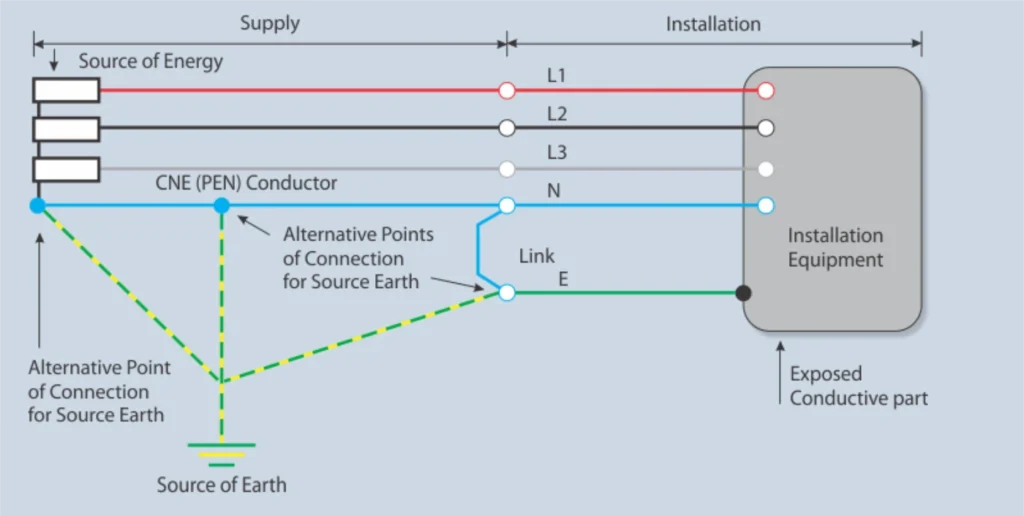TNCS earthing systems are a type of electrical system that protects people and structures from electrical hazards. They ensure the safety and reliability of the installation process.
TNCS (TN-C-S) systems use a combined neutral and earth conductor (C and S). This conductor connects the electrical installation to the ground. In this blog, we will address various questions about TNCS earthing systems. We will cover their purpose, how they differ from other systems, their advantages and drawbacks, and the main components. We will also discuss how to design, install, and maintain a TNCS system. Additionally, we will explore the risks associated with this system and how to mitigate them. Finally, we will consider the factors for selecting a TNCS system for a specific location or building type. Whether you are an electrician, electrical engineer, or just interested in learning more, this blog will provide a helpful overview of TNCS earthing systems.
TNCS (TN-C-S) earthing systems are used in many applications, including residential, commercial, and industrial buildings. They are ideal for electrical installations where the neutral conductor must carry both unbalanced and balanced loads. These systems also provide a low-impedance path to earth in case of a fault or short circuit. Common applications for TNCS earthing systems include distribution systems, electrical panels, switchgear, lighting systems, and power outlets. They may also be used in outdoor installations like street lighting or substations, where the combined neutral and earth conductor ensures an effective earthing system
Role of Combined Neutral & Earth Conductors in TNCS

The purpose of using a combined neutral and earth conductor (C and S) in a TNCS (TN-C-S) earthing system is to provide a low-impedance path to earth during a fault or short circuit. In a TNCS system, the combined neutral and earth conductor (C) carries both unbalanced and balanced loads. The separate earth conductor (S) connects the electrical installation to the earthing electrode. This design allows the TNCS system to provide a low-resistance connection to earth. It helps effectively clear a fault or short circuit, safeguarding people and property from electrical risks.
The use of a combined neutral and earth conductor in a TNCS system also simplifies the electrical wiring, as it eliminates the need for a separate neutral conductor. This can help to reduce costs and improve the efficiency of the electrical installation.
However, the use of a combined neutral and earth conductor can affect the performance of the earthing system in certain ways:
- Using this combination can reduce voltage offsets caused by unbalanced loads.
- TNCS systems can simplify electrical wiring by eliminating the need for a separate neutral conductor.
- TNCS systems may not provide as much protection against earth fault currents as other types of earthing systems, such as TNS (TN-S) systems.
- TNCS systems may be more sensitive to voltage fluctuations and may require more frequent maintenance.
TNS VS TNCS Earthing System
One of the main differences between TNS and TNCS earthing systems is how they connect to the earth. In a TNS system, the electrical installation connects to the earth via a separate earth conductor. This conductor carries fault and short-circuit currents to the earthing electrode. In a TNCS system, the installation connects to the earth via a combined neutral and earth conductor (C and S). This conductor carries both unbalanced and balanced loads, and connects the installation to the earthing electrode.
Another key difference is how unbalanced loads affect the systems. In a TNS system, unbalanced loads can cause the neutral conductor to carry significant currents. This can result in voltage offsets between the neutral and earth conductors. In a TNCS system, the combined neutral and earth conductor carries unbalanced loads, reducing voltage offsets.
There are also differences in installation and maintenance. TNS systems may require multiple earthing electrodes, increasing the cost and complexity. In contrast, TNCS systems are simpler and less expensive to install and maintain since they require only one earthing electrode.
However, TNCS systems have some potential drawbacks that affect maintenance and repair. For example, TNCS systems may not provide as much protection against earth fault currents as TNS systems. This may require more frequent monitoring and testing. Additionally, TNCS systems are more sensitive to voltage fluctuations, which may require regular adjustments to maintain performance. Here’s a detailed explanation of the TNS Earthing System.
Use of TNCS Earthing System with other systems

You can use a TNCS (TN-C-S) earthing system with other earthing systems, such as TN-S (TN-S), TN-C (TN-C), and IT (IT) systems. However, the suitability of combining different earthing systems depends on factors like local electrical codes, soil conditions, building materials, and the size and complexity of the electrical installation.
When using a TNCS earthing system with other systems, ensure that the systems are properly coordinated. All earthing electrodes should connect in a way that ensures the safety and reliability of the installation.
For example, if a construction site uses the TN-C method for its temporary power supply but requires TN-S for compliance, you can divide the main distribution box to maintain the TNCS system. The earth conductor (PE line) should connect separately from the rest of the system.
Material Selection for TNCS Earthing

There are several considerations that should be taken into account when selecting the materials used in a TNCS (TN-C-S) earthing system:
- Conductor size: It is important to select the appropriate conductor size for the TNCS earthing system based on the size of the electrical installation and the expected fault current. Using a conductor that is too small may not be able to safely carry the fault current, while using a conductor that is too large may be unnecessarily expensive.
- Earthing electrode type: There are several types of earthing electrodes that can be used in a TNCS earthing system, including copper plates, rods, and pipes. The selection of the earthing electrode should be based on the soil conditions, the size of the electrical installation, and the expected fault current.
- Corrosion resistance: It is important to select materials for the TNCS earthing system that are resistant to corrosion, as corrosion can reduce the effectiveness of the earthing system and may require frequent maintenance.
- Electrical conductivity: It is important to select materials for the TNCS earthing system that has high electrical conductivity, as this can help to ensure that the earthing system is able to effectively carry fault and short-circuit currents to the earthing electrode.
Testing and Verification of TNCS System

- Use specialised test equipment: It is important to use specialised test equipment, such as earth resistance meters, to accurately measure the performance of the TNCS earthing system.
- Follow proper testing procedures: It is important to follow the manufacturer’s recommended testing procedures and local electrical codes and standards when testing the TNCS earthing system.
- Test all components of the system: It is important to test all components of the TNCS earthing system, including the earthing electrodes, earthing conductors, and earth fault protection devices.
- Record test results: It is important to record the test results and any corrective actions taken to ensure that the TNCS earthing system is properly maintained and functioning correctly.
- Schedule regular testing: It is important to schedule regular testing of the TNCS earthing system to ensure its ongoing performance and to identify any potential issues before they become serious problems.
Conclusion
Axis can provide a range of services to help clients design and install a TNCS (TN-C-S) earthing system, including:
- Design and engineering services: Axis Electricals can provide expert design and engineering services to help clients develop a customised TNCS earthing system that meets the specific requirements and characteristics of their electrical installation. This may include selecting the appropriate materials, sizing the earthing conductors, and selecting the most suitable earthing electrodes.
- Hardware Supply: Axis Electricals can also provide the hardware and materials needed to design and install a TNCS (TN-C-S) earthing system. This may include earthing electrodes, such as copper plates, rods, or pipes, as well as earthing conductors, protective conductors, bonding conductors, and other components.
- Installation services: Axis Electricals can provide professional installation services to help clients install their TNCS earthing system. This may include installing the earthing electrodes, connecting the earthing conductors, and installing any protective devices, such as circuit breakers or fuses.
- Testing and verification services: Axis Electricals can provide testing and verification services to ensure that the TNCS earthing system is installed correctly and is functioning properly. This may include using specialized test equipment to measure the performance of the earthing system and identifying any issues that need to be corrected.
By providing both the hardware and the services needed to install the earthing system, Axis offers a complete solution to clients looking to design and install a TNCS earthing system. Connect with us today for more information!
Thank you for reading the blog, Axis is a leading manufacturer and supplier of Electrical Components to over 80+ Countries. You can also watch our videos by our experts – click here.
Follow us on LinkedIn for regular updates on our Products!









